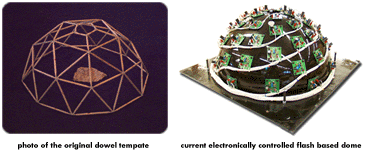
Yale scholar Walter Bodine had spent the better part of four long
years painstakingly transcribing the ancient Sumerian characters inscribed
on a crumbling, 4,000-year-old clay tablet.
Then he met Tom Malzbender, an HP Labs researcher who has invented
a tool that lets scholars see ancient texts in ways never
before possible.
Malzbender's technology for capturing and viewing images of
three-dimensional objects can make characters that were
previously invisible or undecipherable clear enough to read. As
a result, scholars can derive more accurate meanings from the text
- and potentially obtain a better understanding of the past.
"I've been working on these texts for years, trying to figure out
what the lines say," says Bodine, a research affiliate with the
Babylonian Collection at Yale, the nation's premier collection of
ancient cuneiform tablets. "This technology gives me access
to more data than I get when using my own eyes."
In one case, researchers were even able to make out the fingerprint
of the author of a document, imprinted ever so faintly into the
clay thousands of years ago.
"You quite literally have the human touch of 3,000 or 4,000 years
ago," says Bruce Zuckerman, director of the West Semitic Research
Project at the University of Southern California. "Potentially,
this (technology) could mean a profound improvement in our knowledge
of the ancient world."
Traditionally, scholars of ancient texts have scrutinized
the physical tablets, stones or other materials to decipher
and transcribe inscriptions. Trouble is, the tablets are thousands
of years old - they're worn and often crumbling, and the writing
is faded.

By changing the angle or type of light shining on
the tablets, scholars can sometimes see the text more clearly.
In the early 1980s, Zuckerman, a scholar and teacher of the Bible
and ancient Semitic languages at USC, pioneered the use of high-resolution
photographs in the study of ancient writing.
Malzbender's invention, a type of image-based relighting, takes
that technique several steps further by automating the collection
of images and allowing scholars to manipulate the lighting and other
aspects of the image on the screen. By changing the appearance of
the object, the technology brings out surface details previously
invisible to the naked eye.
Malzbender and his collegues in HP Labs' visual computing department,
Dan Gelb and Hans Wolters, didn't set out to change the study of
ancient texts. He was trying to solve problems of existing 3D graphics
rendering technologies, looking for a way to both improve photorealism
and rendering efficiency.
To collect data, Malzbender headed to his basement and built a
geodesic dome - constructed of glued-together wooden dowels
- that would help him control the angle of light. In a darkened
room, he photographed a crumpled-up newspaper 40 times, each time
changing the angle of the light, a table lamp.
It worked. On the screen, he could manipulate the angle of light
to change and enhance the surface appearance of the newspaper.
To speed the data-collection process, Malzbender teamed with fellow
researchers Gelb, Eric Montgomery and Bill Ambrisco to build an
automated dome. This one, a plastic dome with 50 flashbulbs mounted
on its inside surface, takes 50 photos at the touch of a button.
Malzbender next wondered if there were other ways to accentuate
surface details. He wound up developing an entirely new class of
constrast-enhancement mechanisms that can bring out even surface
details.

By changing the optical properties of the imaged object, he can
synthesize specular highlights - that is, he can make a surface
that isn't reflective, such as a clay tablet, appear to be as glossy
as obsidian. Another technique, called diffuse gain, changes how
the surface responds to light. A third method, model extrapolation,
makes the lighting appear more oblique than is physically possible.
Malzbender and other researchers are now working on a freestanding
portable unit that scholars could easily transport to remote sites
to capture images of large objects such as walls or statues.
The image-based relighting technology has the potential to reshape
other fields as well, including forensics and diagnostic medicine,
where materials are degraded or difficult to view.
"It's been really exciting," says Malzbender. "A lot of things
have come out of this we didn't expect."
by Jamie Beckett

|
